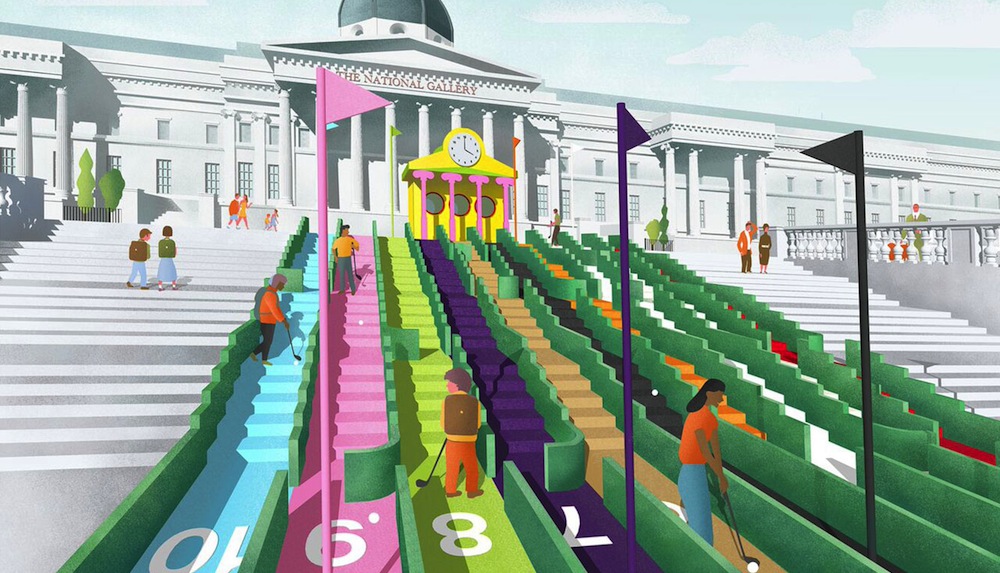The London Design Festival launched a crowdfunding campaign to raise money for one of the craziest mini-golf courses ever made.
The plan is to turn London’s Trafalgar Square into a colorful course this September. Notable designers, including Tom Dixon, Mark Wallinger, and the late Zaha Hadid, each get to create a hole of their own.
Eight holes have been designed for the mini-golf (known in the UK as "crazy golf") course, and they all feature much more than a windmill and a turf incline. Dixon’s hole integrates pneumatic tubes; players must navigate Wallinger’s circular maze; and Hadid designed a curvy, dual-level hole that traces the shadow of the square’s Nelson’s Column. The entries are bright, creative, and, to many putt-putt golfers across the universe, at least a quadruple bogey.
Paul Smith is the project’s visionary. The architect has held other events at Trafalgar Square over the years, including life-size chess and a robot show. Smith’s hole calls for a set of 10 multicolored stairways. The other designers who took part in the project are Camille Walala, Atelier Bow-Wow, HAT Projects, NEON, and Ordinary Architecture, the latter of which envisioned a hole where a player hits their ball into a large pigeon and watches it roll through its digestive tracks.
The project’s goal is to amuse both adults and children, and teach the public about the future of design.
The course “will attract a wide, public audience, and inspire the next generation of creatives,” as its Kickstarter puts it. “Thousands will be able to play the course, and millions more will watch and enjoy this experience, both in the square and through media.”
A little more than $5,000 has been raised thus far. There are still 42 days left to reach the $172,862 goal.
Related Stories
| Oct 5, 2011
GREENBUILD 2011: Johnson Controls announces Panoptix, a new approach to building efficiency
Panoptix combines latest technology, new business model and industry-leading expertise to make building efficiency easier and more accessible to a broader market.
| Oct 5, 2011
GREENBUILD 2011: Software an architectural game changer
Interactive modeling software transforms the designbuild process.
| Oct 5, 2011
GREENBUILD 2011: Tile manufacturer attains third-party certification for waste recycling processes
Crossville has joined with TOTO to recycle that company’s pre-consumer fired sanitary ware.
| Oct 5, 2011
GREENBUILD 2011: Sustainable construction should stress durability as well as energy efficiency
There is now a call for making enhanced resilience of a building’s structure to natural and man-made disasters the first consideration of a green building.
| Oct 5, 2011
GREENBUILD 2011: Solar PV canopy system expanded for architectural market
Turnkey systems create an aesthetic architectural power plant.
| Oct 5, 2011
GREENBUILD 2011: Kohler builds sustainable booth at Greenbuild 2011
In a setting composed of reclaimed materials, biodegradable signage, energy-efficient lighting and more, exhibitor highlights its new products with ecological awareness.
| Oct 5, 2011
GREENBUILD 2011: Brick offers growing options for sustainable building design
Brick exteriors, interiors and landscaping options can increase sustainability that also helps earn LEED certification.
| Oct 5, 2011
GREENBUILD 2011: Roof hatch designed for energy efficiency
The cover features a specially designed EPDM finger-type gasket that ensures a positive seal with the curb to reduce air permeability and ensure energy performance.
| Oct 4, 2011
GREENBUILD 2011
Click here for the latest news and products from Greenbuild 2011, Oct. 4-7, in Toronto.
















